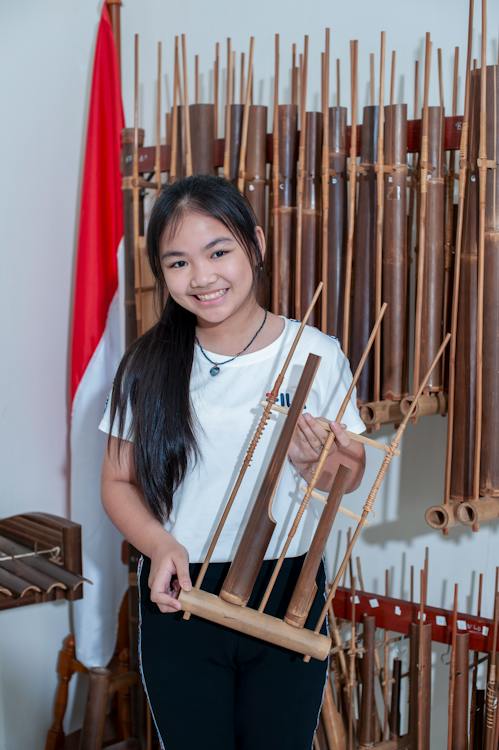A photo of an angklung instrument
The angklung is a percussion musical instrument made out of bamboo. Although this instrumentoriginated from West Java and Banten, the angklung is also notable throughout the world. In fact, the Sundanese people native to the Indonesian province of West Java used the angklung for several centuries. This instrument alsoplayed a big part in the Sundanese people’s cultural identity in West Java and Banten.
The angklung’s bamboo tubes are attached to its bamboo frame. Also, the angklung’s tubes were carved to have a resonant pitch when the instrument is struck and are tuned to octaves. In playing the angklung instrument, the player must hold it in one hand, while the other hand is shaking the instrument. Each performer in the angklung ensemble is usually responsible for just one pitch.
In the subsequent years, the angklung was played in an orchestra. Playing the angklung in an orchestra requires coordination, cooperation, as well as promotes teamwork, social harmony, and respect for other angklung performers. In November 2018, the United Nations Educational, Scientific, and Cultural Organizations (UNESCO) had officially recognized the angklung as a Masterpiece of the Oral and Intangible Heritage of Humanity. The UNESCO also encouraged the Indonesian government and its people to promote performances and craftmanship of the angklung.
Interestingly, the word angklung is said to come from the Sundanese word ‘angkleung-angkleungan,’ suggesting the movement of the player and the ‘klung’ sound coming from the instrument. Another interesting theory about the origin of the angklung’s name was from the two Balinese words ‘angka’ meaning ‘tone’ and ‘lung,’ which means ‘broken.’
A photo of a man playing angklung
The angklung has been the favorite musical instrument of the whole archipelago even before the Hindu era. According to a Dutch ethnomusicologist, Jaap Kunst, aside from West Java, the angklung also existed in South Sumatra Kalimantan. Also, East Java, as well as Central Java, are familiar with the angklung. During the Hindu period, the angklung played an essential role in several ceremonies. For instance, the angklung was played to honor the goddess of fertility, Dewi Sri, to bless their land. Besides, this instrument was used as a signal for time of prayer during the 7th century in the Kingdom of Sunda. The angklung had also played a part in providing martial music during the Battle of Bubat as it was told in the KidungSunda.
Interestingly, the oldest angklung that had survived through the years was the Angklung Gubrag, which was made way back in the 7th century in Jasinga, Bogor. Meanwhile, other ancient angklung instruments were stored in the Sri Baduga Museum in Bandung, the capital of West Java. Even before, the oldest and known angklung tradition was called the angklung buhun, meaning ‘ancient angklung.’ This ancient angklung is the angklung used during the harvest ceremony of the Baduy people, a traditional Bantenese community of the inland Banten province.
A photo of a single pitch angklung used in the orchestra
In 1938, a famous music teacher, DaengSoetigna, of Bandung, had created an angklung instrument that was based on the diatonic scale instead of the traditional gamelan music scale of pelog or siendro. Afterward, angklung’s popularity had returned. In fact, it has been used for entertainment as well as educational purposes and also as an accompaniment of Western instruments in an orchestra. One of the angklung’s first performances in an orchestra was during the Bandung Conference, an Afro-Asian conference held in Bandung, Indonesia, in April 1955.
Subsequently, in the following year, Soetigna’s student named UdjoNgalagena opened his House of Angklung in order to preserve and develop angklung instruments. In November 2010, this instrument officially declared the angklung as a Masterpiece of the Oral and Intangible Heritage of Humanity. Meanwhile, in Bali, the angklung was included in their ensemble called Gamelan Angklung. This ensemble is usually composed of twenty musicians with bronze metallophones, the instruments that are made out of metals.
The Gamelan Angklung ensemble is usually heard in Balinese temples. This ensemble supplies musical accompaniment during temple anniversaries and rituals to death. Thus, it is then connected to the invisible realms and transitions from life, death, and beyond. In addition to that, the portability of this ensemble allows it to be carried in processions while the funeral bier is moved from the temporary burial site up to the cremation ceremony.

